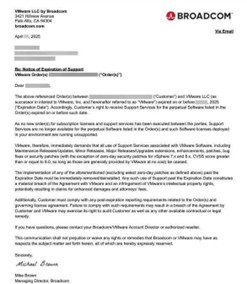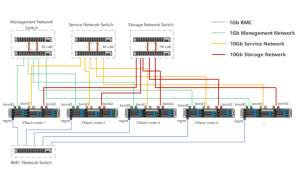ZStack Cloud Platform
Single Server Deployment with Full Features, Free for One Year
In the current wave of digital transformation, enterprises’ demand for cloud infrastructure is growing, and migration from VMware to other platforms has become a focus for many companies. With Broadcom’s acquisition of VMware and subsequent strategic changes, many enterprises face urgent needs to migrate from VMware.
So, what should be considered when migrating from VMware to other platforms? What server adaptation brands are available for VMware migration? What storage adaptation brands are available for VMware migration? What operating system adaptation brands are available for VMware migration? What network adaptation brands are available for VMware migration? How to migrate from VMware to other platforms? How should the compatibility of migrating from VMware to other platforms be evaluated? Is there a practical VMware migration operation guide to help us transition smoothly? Additionally, what VMware migration tools are available on the market? These questions trouble many enterprises. Today, we will explore these issues in depth.
After Broadcom’s acquisition of VMware, the market landscape is undergoing significant changes. Media reports indicate that Broadcom is aggressively promoting a new subscription bundle model, particularly targeting medium and large user groups.
Recently, to promote subscription services, Broadcom even sent “cease and desist” letters to VMware perpetual license holders with expired support contracts, warning them that continuing to install updates and patches without signing new contracts constitutes infringement and must stop immediately, with relevant content uninstalled. The letters also mentioned that if customers fail to fulfill relevant reporting obligations, VMware has the right to conduct audits and pursue legal liabilities.

These measures have led many enterprises to seek VMware to ZStack. For example, according to CRN, Toshiba decided to migrate 2,200 virtual machines from the VMware-Broadcom platform to other platforms after VMware product costs soared to 10 times the original price.
A co-founder of a European cloud infrastructure provider also stated that Broadcom has clearly indicated that small and medium-sized enterprises no longer align with its strategic direction, so they are actively advising clients to consider other alternatives.
Gartner’s “Global Server Virtualization Market Guide” points out that the server virtualization market is facing the most significant disruptive changes in over a decade. This judgment stems from Broadcom’s acquisition of VMware and the subsequent change in product sales models—from terminating perpetual licenses to subscription sales—leading to increased enterprise operational expenses (OPEX). Additionally, the restructuring of standalone products into four major subscription bundles has also increased user costs. Gartner predicts that by 2028, cost issues will drive 70% of enterprise-level VMware customers to migrate 50% of their virtual workloads. Currently, in multiple countries and regions across finance, healthcare, education, manufacturing, research, and over ten other industries, a movement from VMware to ZStack is underway.
For enterprises looking to maintain business continuity, reduce costs, and minimize risks, ZStack is becoming an attractive option. We previously introduced three paths to VMware to ZStack with ZStack ZSphere products; now, we will focus on interpreting ZStack ZSphere’s technical ecosystem compatibility information.
ZStack ZSphere provides a user experience consistent with VMware virtualization.
|
Server Manufacturer |
Model |
Type |
|
HP |
HP DL360p Gen8, HP DL380 G7, HPE CL2200 Gen10, etc. |
Rack-mounted |
|
DELL |
Dell C6220 II, Dell R510, Dell R940, etc. |
Rack-mounted |
|
Lenovo |
Lenovo System x3650 M5, Lenovo ThinkSystem SR530, Lenovo ThinkSystem SR860, etc. |
Rack-mounted |
|
Supermicro |
SYS-2028TR-H72R, SYS-2028TR-HTR, etc. |
Rack-mounted |
|
OS Manufacturer |
Operating System |
Architecture |
OS Bit Version |
|
Red Hat |
CentOS 6.x, CentOS 7.x, Enterprise Linux 6.x |
ARM, X86 |
32, 64 |
|
Oracle |
Oracle Linux 6.x, Oracle Linux 7.x, Oracle Linux 8.x |
x86 |
64 |
|
Novell |
SUSE Linux Enterprise Server 12, SUSE Linux Enterprise Server 11, SUSE Linux Enterprise Server 10 |
x86 |
32, 64 |
|
Microsoft |
Windows 2008 Essential Business Server, Windows 2008 Small Business Server, Windows 2016 |
x86 |
32, 64 |
Click to view more ZStack compatible products
Below is a successful case of VMware to ZStack:

(Solution topology diagram)
Click to view more ZStack compatible products
ZStack is not only a leading cloud infrastructure provider but also a pioneer in AI infrastructure. The ZStack Cloud Platform offers comprehensive data center infrastructure solutions, including private cloud platforms with 4S characteristics. The ZStack ZSphere Virtualization Platform aims to provide a user experience consistent with VMware. Additionally, ZStack offers products such as ZStack HCI, software-defined storage (ZStack SDS), and more. In broader fields, ZStack also provides data center management platform ZStack ZCenter and ZStack CMP, edge orchestration platform ZStack Edge, cloud-native platform ZStack Zaku, and database management platform ZStack RDS.
Particularly noteworthy is ZStack AIOS, a privatized AI infrastructure platform. AIOS fully supports enterprise AI applications in three key areas: “computing power scheduling, AI large model training and inference, and AI application service development.” AIOS aims to provide enterprises with a privatized AI infrastructure platform supporting enterprise-level AI applications.